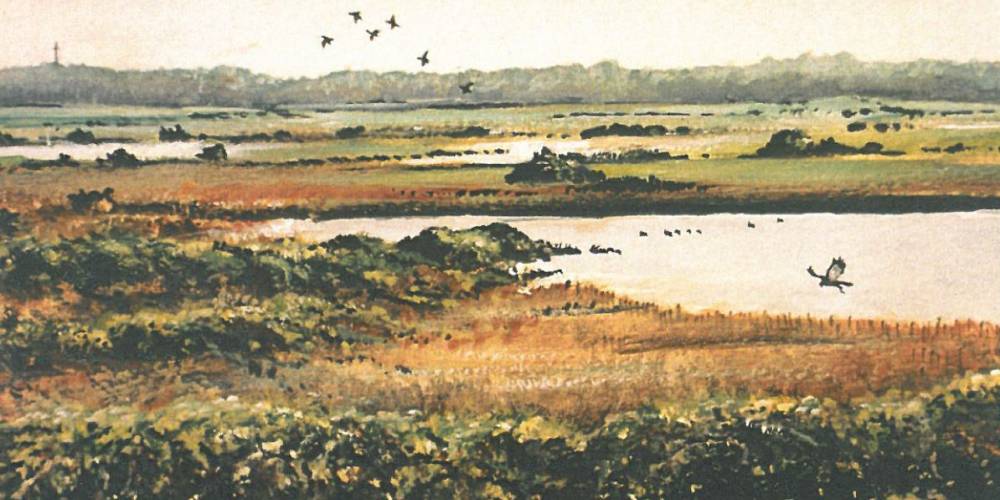
NSA loses dedicated Vice President
25th August 2016
It is with great sadness that NSA shares the news of the unexpected death on Monday of Keith McDougall, an NSA Vice President and former NSA Chairman (1986-1988).
Mr McDougall was an active supporter of NSA and regular correspondent with NSA HQ on a range of topics, particularly the positive links between sheep and the environment. You can read some of his views here. His dedication and enthusiasm was recognised in 1999 when he was presented with the NSA George Headley Memorial Award for outstanding contribution to the sheep sector.
He was also an accomplished artist and an example is pictured here, featuring the Holkham Nature Reserve near his home in Norfolk.
The funeral will take place on Wednesday 7th September, 2pm at St John the Baptist Church, Church Street, Stiffkey, Norfolk, NR23 1QJ. Tea will be served afterwards at Hall Farm, Langham Road, Morston, for anyone who wishes. Please contact the NSA office for further details.
Remembering our friend and colleague Keith McDougall, by Michael Pollitt
A Norfolk farmer and pioneering cattle breeder, conservation enthusiast, artist and passionate advocate for wildlife and nature, Keith McDougall has died aged 82.
He was chairman of Norfolk Naturalists’ Trust (now Norfolk Wildlife Trust) during its 60th diamond jubilee. A reception at the Norwich Union’s Marble Hall with BBC television presenter Valerie Singleton in May 1986 took place just three months after a special celebration lunch at the Cley Hotel, where the trust had been founded on 14th March 1926.
Keith Arundel McDougall was born on 21st January 1934, the third son to Douglas McDougall, a businessman and renowned wildfowler. When he was 11 years old, his father bought Catfield Hall farm in Broadland. It was then and remains today a special wildlife wilderness of reed beds, dykes and birds. As he later recalled when the farm was sold in 1993, following his father’s death, it originally employed four men on 250 acres; had two Suffolk punches and even made a profit. His father had founded a herd of Poll Herefords using imported blood lines from New Zealand in 1955 when the pedigree Essex Saddleback pigs were being phased out.
He went to Taverham Hall and then Sherborne School, when an expedition to Spitzbergen ringing wild geese in 1952 made a deep impression. After National Service as an officer in the Royal Norfolk Regiment in Hong Kong, he went up to Cambridge to read agriculture. In 1956, he was one of six undergraduates on the university’s 3,000-mile overland trip by landrover to Teheran. As a member of the North Persian expedition, he reported for the Eastern Daily Press on his plant finds in the little-known Elburz Mountains, south of the Caspian Sea.
He spent nine years in export roles with the family firm of agricultural chemicals, Cooper, McDougall & Robertson, now part of the Wellcome Foundation. In 1967, he joined the Norwich-based Ross poultry division as overseas sales manager. But farming was his main love. He ran Catfield Hall and was a farming partner at Chalk Hill on the Holkham estate with the former Earl of Leicester for many years. He was chairman of the National Sheep Association between 1986 and 1988 and later a vice president. In 1999, he received the George Hedley Memorial Award for his contribution for advocating balanced farming techniques in the sheep sector. Sharing his father’s enthusiasm for cattle breeding, he started the Fenside herd at Catfield by importing Salers from the Auvergne in central France in 1987. Soon, it had expanded to 14 pedigree heifers alongside the polled Herefords. In 1985, he won the Royal Norfolk Show’s supreme beef championship with a home-bred Catfield bull.
During his term as chairman of Norfolk Naturalists’ Trust, he was involved in the adoption of the new name, which was controversial in the late 1980s. Also involved in the Boards Society, he was founding chairman of the How Hill Trust, which runs the environmental education centre.
While he enjoyed shooting, especially in the remote highlands and islands of Scotland, he was as successful with a palette and brush. In 2009, he published a 450 limited edition of “A Special Kind of Light” of Scottish and Norfolk landscapes. It followed his book, Middle Marsh, published in 1991 and set around the then family home of Catfield.
He served on many other committees including the Heather Trust, the British Association for Shooting and Conservation and Holkham National Nature Reserve. For six years he was policy director of the Norfolk-based charity Songbird Survival, where his deep knowledge of wildlife, the countryside, farming and conservation matters guided the charity through a period of great change and growth. Among his many other interests, he was a pianist and also chairman of the Stiffkey Local History Group, formed in 2008.
He met his future wife, Jane, at Cambridge and they married in January 1958. He leaves a widow, his son, four daughters and six grandchildren.


